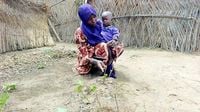On September 20, 2025, the Trump administration made a sweeping announcement that reverberated from America’s kitchens to refugee camps thousands of miles away: the federal government would terminate its annual report on food insecurity in the United States. The decision, described by the U.S. Department of Agriculture (USDA) as a move to eliminate a “redundant, costly and politicized” study, came on the heels of massive cuts to domestic and foreign food assistance programs. For millions of vulnerable families, both at home and abroad, the consequences have been immediate and profound.
“For 30 years, this study — initially created by the Clinton administration as a means to support the increase of SNAP eligibility and benefit allotment — failed to present anything more than subjective, liberal fodder,” the USDA declared in a statement, referencing the Supplemental Nutrition Assistance Program (SNAP), better known as food stamps. The agency insisted that “trends in the prevalence of food insecurity have remained virtually unchanged, regardless of an over 87% increase in SNAP spending between 2019–2023.” According to The Wall Street Journal, the USDA will publish one final hunger report in October 2025 before ending the series for good.
This policy shift arrives at a time when the Republican-controlled Congress and President Donald Trump have enacted a domestic agenda slashing SNAP benefits. According to an August 2025 analysis by the Congressional Budget Office, an estimated 2.4 million fewer Americans—including families with children—will receive food stamp benefits each month after lawmakers expanded work requirements for parents, older adults, and other recipients. For those who remain eligible, monthly assistance is shrinking just as grocery prices remain stubbornly high and food banks face increased demand. In May 2025, nearly 42 million people relied on food stamps, with the average benefit just over $188 per person, the USDA reported.
The most recent federal data, soon to be discontinued, showed that about 13.5% of U.S. households experienced food insecurity at some point in 2023—a rise from 12.8% the previous year. Notably, food insecurity among families with children had declined in 2021, a shift experts attributed to the enhanced child tax credit during the pandemic. But after that credit lapsed, hunger rates climbed once more. Despite this, the USDA now claims that the survey’s questions “do not present an accurate picture of actual food security.”
This skepticism toward longstanding data sources is not isolated. The Trump administration has also cast doubt on the government’s monthly jobs report, even firing the commissioner responsible for it in August 2025. Former Department of Labor officials from both parties have contested the administration’s claims, but the pattern is clear: key measures of economic hardship are being sidelined or scrutinized under the current administration.
Advocates for low-income Americans have voiced alarm at these developments. “By cancelling the survey, USDA is sending a signal that tracking and battling hunger is no longer a priority,” Eric Mitchell, president of the Alliance to End Hunger, told CNN. “With continuing worries about food inflation, as well as significant cuts to America’s largest food assistance program – SNAP – this move is a blow to policymakers and advocates who rely on the data to improve the lives of our food insecure neighbors.”
The impact of U.S. policy shifts is not confined to American borders. In March 2025, a U.S.-funded nutrition program in northeastern Nigeria was abruptly halted after the Trump administration froze foreign aid and cut support for programs that aid groups deemed lifesaving. The consequences were heartbreakingly clear for Yagana Usman, a mother sheltering in Borno state’s Fulatari camp. Usman lost one of her infant twins to malnutrition just days after the therapeutic food packets provided by the U.S. Agency for International Development (USAID) stopped arriving. “There was nothing I could afford to give them to survive, so the babies died of hunger,” Usman recounted to CNN.
The ripple effects of these cuts have been felt across Africa. In March, UNICEF warned that nearly 1.3 million children under five in conflict-affected northeastern Nigeria and Ethiopia’s Afar region could lose access to lifesaving treatment as funding vanished. By August, Save the Children reported that millions of malnourished children in Kenya, Somalia, South Sudan, and other countries were also at risk. The UN World Food Programme (WFP) echoed these alarms, noting that its funding from international donors was “drying up,” forcing reductions in food and nutrition assistance to hundreds of thousands in northeastern Nigeria alone. More than 150 WFP-supported nutrition clinics in the region faced closure.
While U.S.-funded food assistance to displaced people in Nigeria’s Borno state resumed by mid-September, aid workers told CNN that projects restarted at a much lower capacity. The U.S. State Department pointed to recent contributions—$93 million to help nearly one million malnourished children in 13 countries and $52 million to WFP for emergency food aid—as evidence of ongoing American generosity. “It is imperative to remember that the American taxpayer was never meant to bear the full burden of taking care of every person on Earth – whether that be with food, medicine, or otherwise. Despite this, America continues to be the most generous nation in the world,” a State Department spokesperson said.
But for families like Usman’s, these gestures feel like temporary reprieves. In July, her surviving twin was readmitted to a reopened nutrition program and began receiving critical care once more. Yet, the threat of further funding cuts looms large. Mercy Corps, the nonprofit implementing the program, was forced to close 42 projects earlier in 2025, affecting over 3.6 million people in crisis hotspots worldwide. “For some of these large-scale food aid programs or programs that we implement at scale in the hardest places around the world, it’s very hard to fill some of those gaps with private resources,” Margaret Schuler, chief impact officer at World Vision, told CNN. Her organization alone saw about $100 million in U.S. government funding vanish, impacting programs in more than 20 countries.
Meanwhile, the Trump administration has canceled over 80% of USAID programs and shifted foreign aid administration to the State Department, which critics say has not matched USAID’s legacy of targeted humanitarian work. The administration is also seeking to freeze another $4.9 billion in foreign aid approved by Congress in 2024, arguing that it no longer fits “America-first” priorities.
Globally, the stakes are staggering. The Integrated Food Security Phase Classification (IPC) estimates that 5.4 million children under five in Nigeria’s northeast and northwest suffer from acute malnutrition, with 1.8 million facing severe acute malnutrition. “Almost every month, we encounter stories like these,” said Hassan Abubakar Bukar, a nutrition counselor in Borno, describing the relentless toll of hunger on children. Experts cited by CNN estimate that hundreds of thousands of children may die worldwide in 2025 as a result of U.S. foreign aid cuts.
Despite these grim realities, U.S. foreign aid remains less than 1% of the federal budget, with $3.8 billion allocated to Africa last year. Advocates argue that such investments yield enormous returns—not just in lives saved, but in global progress against infectious diseases and poverty. “We really believe that foreign aid is a great investment for the US government in terms of the return it brings,” Schuler said.
The world, it seems, is watching as America recalibrates its role in the fight against hunger. For mothers like Yagana Usman, the question is heartbreakingly simple: will her surviving child—and millions like him—have enough to eat tomorrow?


